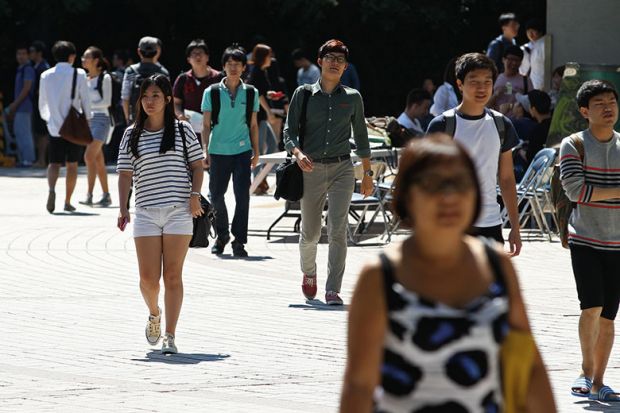Bruce Chapman is on a mission to protect students from debt-hungry creditors, and to protect creditors from students who cannot pay.
The father of Australia’s income-contingent loan system, arguably the nation’s most influential higher education export, is on his latest foray to help shield taxpayers from graduates who do not repay their tuition fee loans – and graduates from lenders who demand the impossible.
In the next few weeks alone, he is travelling to Hong Kong, where there is “hunger for a debate about student loans”, said the professor of economics at the Australian National University, and to Brazil to promote the idea he pioneered when Australia adopted the Higher Education Contribution Scheme (HECS) in 1989.
Professor Chapman said the benefits of income-contingent loans ranged from the personal – with graduates spared the stress and life-limiting consequences of debt – to the national. Compared with “normal” loans, income-contingent loans save taxpayers significant sums of money while easing constraints on university participation. “In countries with ICLs, the systems have grown substantially,” he said.
Under HECS, since rebadged the Higher Education Loan Programme, the Australian government pays tuition fees in advance and students repay the money through taxation after their annual incomes reach a set threshold – currently A$45,881 (£25,669).
Variations on this approach have been adopted in England, New Zealand and Hungary, with each setting different thresholds, repayment rates and indexation of accumulated debt.
Professor Chapman said four more countries were “on the verge” of establishing income-contingent loan schemes, with Brazil, Colombia and Japan finalising programmes after having passed legislation to implement them. Malaysia announced its own scheme in December and is now consulting on its structure.
Japan already has a partial income-contingent loan scheme available to perhaps 10 per cent of its poorest graduates. Ethiopia, South Korea, Namibia, the Netherlands, Thailand and the US also have hybrid approaches, but Professor Chapman said many of these halfway schemes were poorly designed.
In the US, where about a quarter of graduates have access to income-contingent loans, there are multiple schemes with varying rules. One treats outstanding debt as income after 20 years, leaving some graduates with tax bills that exceed their earnings.
The problems with traditional time-based repayment loans are evident in soaring default rates. Professor Chapman said there were no defaults on income-contingent loans because people lacking the capacity to repay were not required to do so.
By comparison, default rates average about 15 per cent to 20 per cent in Canada and the US, and 50 per cent in Brazil, Colombia, Malaysia and Thailand – with taxpayers rather than finance companies ultimately footing the bill.
Professor Chapman said that even in countries where banks lend the money, governments guarantee it. “All the risks are borne by government,” he said. “If somebody doesn’t pay off a student loan, that’s a problem for the taxpayers.”
While the same is true of income-contingent loans, with estimates that at least 16 per cent of Australian student lending is never repaid, Professor Chapman said governments with such a system are still better off – partly because some graduates eventually repay the money after their circumstances improve, but mainly because compliance costs are much lower.
“In Australia, for every dollar you spend collecting HECS, you raise over $1,000 a year,” he says. “Colombia, Malaysia and Brazil have hundreds of public sector administrators chasing debt.
“Countries use the tax system to collect income tax, and in some cases social security and medical insurance, but not student debt. This major public sector administrative efficiency is not being used.”
Meanwhile, Professor Chapman said the poorest 20 per cent of male graduates faced student debt repayments that are above 40 per cent of their income in Brazil and the US, 50 per cent in the Republic of Ireland and 100 per cent in Colombia and South Korea. Many default, undermining their prospects of borrowing money in the future.
For others, debt erodes independence. Professor Chapman said female Japanese graduates’ debts were often paid by their spouses, because many leave work after marrying, while many South Koreans remain dependent on their parents well into their twenties.
He said there was indirect evidence that debt burden was hampering the development of higher education. “In some countries, survey data suggest that poor people in particular are averse to taking loans – if they haven’t got access to finances, there will be people not going,” he said.
The Australian National University has estimated that more than 15 million people worldwide have benefited from income-contingent loans to date. Professor Chapman said that his team’s modelling suggested that the sky is the limit.
“We’ve looked at it now for about 20 different countries,” he said. “It’s hard to tell a negative story about this.”
john.ross@timeshighereducation.com
Bruce Chapman will be discussing higher education financing at the Times Higher Education Leadership and Management Summit, held at City University of Hong Kong from 17 to 19 July.
POSTSCRIPT:
Print headline: Income-contingent loans get huge interest, pioneer says
Register to continue
Why register?
- Registration is free and only takes a moment
- Once registered, you can read 3 articles a month
- Sign up for our newsletter
Subscribe
Or subscribe for unlimited access to:
- Unlimited access to news, views, insights & reviews
- Digital editions
- Digital access to THE’s university and college rankings analysis
Already registered or a current subscriber? Login










